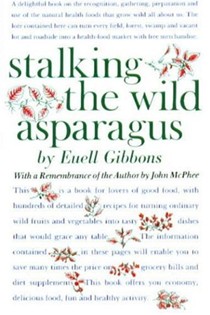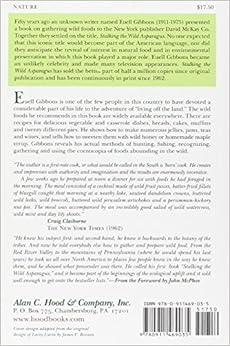


which eventually evolved into a nonfictional paean to the art of foraging. Gibbons accepted her advice - and her financial support - and began work on a novel. It was in the period between that down payment and their 1963 relocation to the 13-acre Pennsylvania homestead (which cost a total of $5,000) that Freda urged Euell to work full time on his writing.

After overcoming Euell’s initial lack of enthusiasm, she mailed in a $50 down payment, and the couple began to make plans to visit the property sometime. She remembers that she “woke up in the middle of the night when it became clear to me that we should try to buy it”. Interestingly enough, Euell and Freda (his second wife, whom he met in 1948 and married soon thereafter) spent eight years in making that final move to a permanent residence.

It was while residing in Snyder County, though, that he was able to pull together his years of experience in the volumes that followed Stalking the Wild Asparagus. During the years between, he lived - as a hobo, beachcomber, teacher, surveyor, cottonpicker, boat-builder, and more - in the Philadelphia area, Washington state, Indiana, California, New Mexico, Maine, Hawaii, and the South Seas. He was born in Texas in 1911, and didn’t settle down in his rural Snyder County, Pennsylvania home (shown in the accompanying photo) until 1963. You see, for much of his life Gibbons was cursed (or blessed) with wanderlust. since, through his publications, many of us discovered that plant species we’d once considered useless pests are actually valuable wild foods.Īnd since every environmentalist is influenced by his or her particular environment (and make no mistake about it, foraging, like gardening, is an activity that almost demands an increase in one’s ecological awareness), one might well wonder just what sort of terrain helped trigger Euell’s creative energy. Well, given that definition, it can be argued that Euell Theophilus Gibbons was a great eradicator of weeds. and then went on to define the word as “a plant whose virtues have not yet been discovered”. Euell Gibbons Wild Foraging and Environmentalism Legacyīack in 1878, Ralph Waldo Emerson posed the question, “What is a weed?”. In the 20 years that have passed since the publication of Stalking the Wild Asparagus, Euell Gibbons’ writings have introduced wild foraging and environmentalism to millions.


 0 kommentar(er)
0 kommentar(er)
